
The Duchy of Schleswig was a duchy in Southern Jutland covering the area between about 60 km north and 70 km (45 mi) south of the current border between Germany and Denmark. The territory has been divided between the two countries since 1920, with Northern Schleswig in Denmark and Southern Schleswig in Germany. The region is also called Sleswick in English.

Ribe Amt is a former county on the Jutland peninsula of southwest Denmark. It included Denmark's fifth largest city, Esbjerg. The county was abolished effective January 1, 2007, when it merged into Region of Southern Denmark. It was often considered coterminous with South West Jutland.
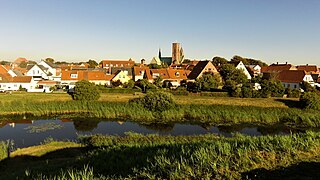
Ribe is a Danish town in south-west Jutland, with a population of 8,287 (2021). It is the seat of the Diocese of Ribe covering southwestern Jutland.
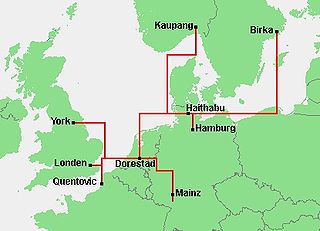
Dorestad was an early medieval emporium, located in the southeast of the province of Utrecht in the Netherlands, close to the modern-day town of Wijk bij Duurstede. It flourished during the 8th to early 9th centuries, as an important port on the northeastern shipping routes due to its proximity to the fork in the Rhine, with access to Germany via the Nederrijn, to the southern Netherlands, northern France, and England, and to the northern Netherlands, northern Germany, and Scandinavia.
The Danes were a North Germanic tribe inhabiting southern Scandinavia, including the area now comprising Denmark proper, and the Scanian provinces of modern-day southern Sweden, during the Nordic Iron Age and the Viking Age. They founded what became the Kingdom of Denmark. The name of their realm is believed to mean "Danish March", viz. "the march of the Danes", in Old Norse, referring to their southern border zone between the Eider and Schlei rivers, known as the Danevirke.

Uppåkra is a village and parish in Staffanstorp Municipality, in Scania, southern Sweden, located five kilometres south of Lund. The village is known for its Iron Age archaeological site, which has been actively excavated since 1996.

Mandø is one of the Danish Wadden Sea islands off the southwest coast of Jutland, Denmark in the Wadden Sea, part of the North Sea. The island covers an area of 7.63 square kilometres and had 40 inhabitants in January 2018. The island is part of Esbjerg Municipality and is situated approximately 12 kilometres southwest of the ancient town of Ribe.

Valby (help·info) is one of the 10 official districts of Copenhagen, Denmark. It is in the southwestern corner of Copenhagen Municipality, and has a mixture of different types of housing. This includes apartment blocks, terraced housing, areas with single-family houses and allotments, plus the remaining part of the old Valby village, around which the district has formed, intermingled with past and present industrial sites.
Ribe Municipality is a former municipality in Denmark. It was located on the west coast of the Jutland peninsula and belonged to Ribe County. It was abolished effective 1 January 2007. The municipal seat was located in the town of Ribe.
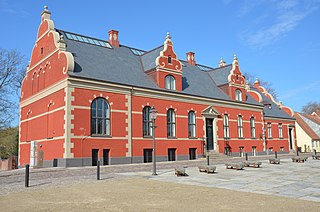
Ribe Kunstmuseum is an art museum in Ribe, Denmark.
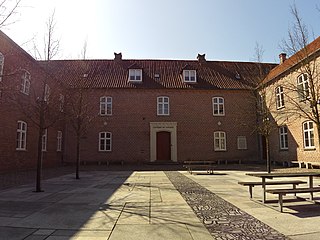
Ribe Katedralskole is a cathedral school in the town of Ribe, Denmark. The school was first mentioned in 1145, making it one of the oldest schools in the world. The oldest building still in use, Puggård, is from the fourteenth century. Except for churches, this is the oldest Scandinavian building still used for its original purpose.
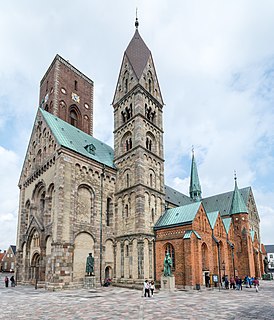
Ribe Cathedral or Our Lady Maria Cathedral is located in the ancient city of Ribe, on the west coast of southern Jutland, Denmark. It was founded in the Viking Era as the first Christian church in Denmark by Ansgar, a missionary monk from Hamburg, under permission of the pagan King Horik I. The cathedral has experienced several damaging events throughout its long history and has been restored, expanded and decorated repeatedly. As it stands today, Ribe Cathedral is the best preserved Romanesque building in Denmark, but reflects a plethora of different architectural styles and artistic traditions. It ranks among the most popular tourist attractions in Denmark and has been awarded two stars in the Michelin guide.

Løgum Abbey was a Cistercian monastery in the present town of Løgumkloster in North Schleswig, Denmark. In 1548, the monastery was closed down. The site is now occupied by Løgumkloster Church.
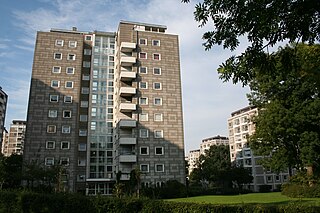
Bellahøj is an area situated 5 kilometres to the northwest of central Copenhagen, Denmark. It features the Bellahøj Houses, a functionalist housing project, as well as parkland with an open-air theatre. The 37 metre high hill situated in Bellahøj Park is the highest point in Copenhagen. The area offers an extensive view over the skyline of Copenhagen.
Torsted is a parish in eastern Jutland, Denmark.

St. Catherine's Priory was an important early Dominican friary, located in Ribe, Denmark from 1228 until 1536. The buildings still stand, although there is no monastic community there. Known as Ribe Kloster, it is Denmark's most complete extant monastic building complex.
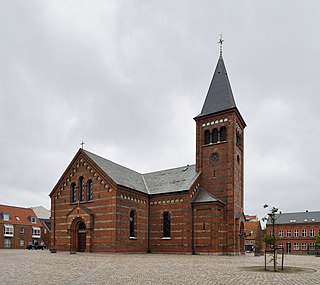
The Church of Our Saviour is a parish church in Esbjerg, Denmark. Completed in 1887 to a design by Axel Møller, it was the first church to be built in the rapidly growing new town.
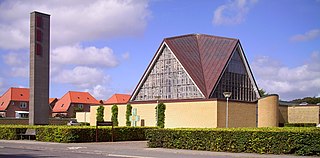
Trinity Church is a modern church in Esbjerg in the southwest of Jutland, Denmark. Designed by local architects Erik Flagstad Rasmussen and Knud Thomsen, the yellow-brick building with large triangular stained-glass windows was completed in 1961.

Vestergade is a street in Aarhus, Denmark, which runs east to west from the central square of Store Torv to the city park of Åparken at Carl Blochs Gade, intersecting the main streets of Grønnegade and Vester Allé along its course. Vestergade begins in the Indre By neighborhood and ends in neighborhood of Vesterbro, close to CeresByen. Vestergade has some of the best preserved 18th-century merchant estates in Aarhus and a history of creativity and artistic expression.